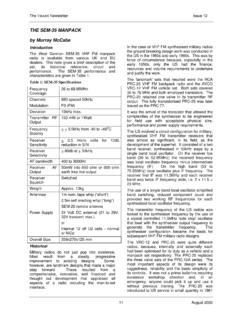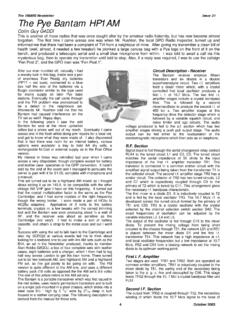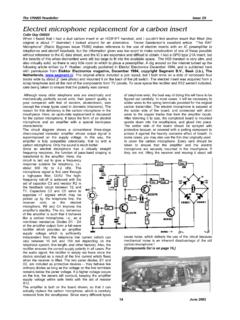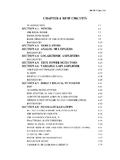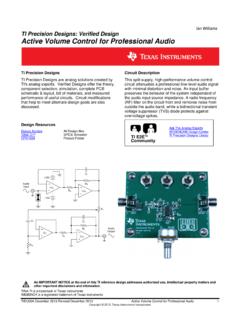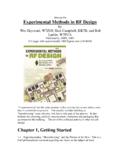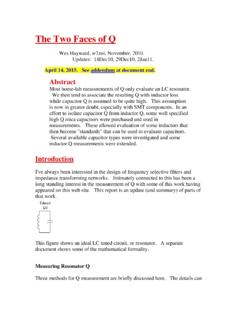Transcription of The SR A41 No - VMARSmanuals
1 The VMARS NewsletterIssue 87 December 1999 THE SR A41 is the story of an end and a Radio (SR) A41 was the last Mk ofthe British Army A41 VHF FM backpacktransceiver. It was also the first fullytransistorised British military VHF FM manpackradio. In , Chris Horswell gave a goodpart-page resum of its history and generalcapabilities. According to Chris only about 50 ofthe sets were produced by Bush MurphyElectronics in 1966 and then disposed of in1971. This note considers the SR A41 inmore detail, its circuitry and performance andthe historical conditions that may explain why itwas the mid 1950s national military authoritieswere starting to draw up concepts for VHF FMbackpack radios to replace the PRC-10 series ofsets.
2 These US designed radios were also usedby Holland, France and Germany and had beenthe base design for the British A41 and A42 andfor the Canadian CPRC-509 and -510 main thrusts of the developing requirementswere to: put the full military VHF tactical spectruminto one box rather than cover it with threesets (the PRC-8,-9 and -10), to reduceset types, improve logistics and increaseoperational flexibility reduce channel spacing and so increase thenumber of available channels simplify set controls, dispense with variabletuning and netting and reduce the need forspecialised operator training employ transistors for improved reliability,reduced portage load and lessened powerdemands on the batteryIn 1962, RCA completed the development of thefirst transistorised and synthesised VHF FMbackpack for the US military, the PRC-25( ).
3 It produced a nominal 2+ watts RFoutput, covered 30 to in 920channels and allowed two channels to be pre-selected. The set retained one valve in thetransmitter output stage, awaiting thedevelopment of suitable RF power PRC-25 introduced two further significantadvances: The 150Hz tone squelch. This required noadjustment and was claimed by theAmericans to have been 'grunt proofed'. A Dynamic, electro-mechanical, microphoneinsert replaced the older carbon insert thatcould have poor environmental withstandand variable the mid 60s the French (Thomson-CSF) andthe Germans (Standard Elektrik Lorenz) werewell advanced in their hardware development forthe PRC-10 series replacements.
4 The Frenchset, the TR-PP-13, (ER-95), covering 26 to 72 MHz and providing watts of RF wasintroduced in 1966 ( ). The German set wasthe SEM 35 ( ). It covered , produced a maximum RF output of 1watt and was introduced in 1968 ( ). Bothsets were fully transistorised. The TR-PP-13employed 43 transistors and the SEM 35 had PRC-25, French and German sets weremechanically tuned, analogue synthesised setswith 50kHz channel spacing and IF frequenciesin the region of 11 MHz. The German set wasunusual in that it employed bulky mechanicalpermeability tuning like the car radios of its arose because it shared a commondevelopment (and two main modules) with thelarger SEM 25 vehicle set.
5 The French on theother hand combined the TR-PP-13development with its associated squad radio theTR-PP-11 'handie-talkie' with which it sharedcommon had decided to await the development ofdigitally synthesised, electronically tuned were to be the Clansman series. TheClansman replacement for the A41 and A42 wasthe PRC-351, scheduled for first deliveriesThe VMARS NewsletterIssue 8 December 19998around 1970. It would cover 30 to 80 MHz in1841 channels with 25kHz channel spacing,provide remote control and re-broadcastadapters built into the set and 150Hz tonesquelch. Its size and weight would be reducedby the use of integrated circuits, (some of whichwould be custom devices) and flexible printedcircuit boards (PCBs).
6 The A41 10 foot whip provided ranges of up to10 km. However, this large whip was veryrestrictive for portable, manpack operation inwooded country or in urban environments. Itwas also a clear and obvious 'target designator'for enemy fire. To remedy matters, the PRC-351 would provide a 4 watt RF output, soallowing it to provide set-to-set ranges of over8km on a relatively inconspicuous four foot were ambitious targets for their day,especially since the PRC-351 without its batterywas to be similar in size to an A40 without itsbattery box. There must have been concern insome quarters that the above targets could notbe met in the programme time.
7 Also, theenhanced technology had to be paid for, makingthe PRC-351 significantly more expensive thanthe the Clansman prototypes were availableBritain would have limited experience ofoperating military transistor VHF FM sets in thefield. The American experience with early PRC-25 sets showed that there was a down side tousing transistors. In the late 50s and early 60sthe dynamic performance of transistors in RFcircuits was not fully understood. Comparedwith valves they had poor cross modulation,intermodulation, blocking and overloadcharacteristics, not all of which showed up in theestablished laboratory tests of the early PRC-25s the first receiver RF amplifiertransistor had no protection against high reversebase-emitter voltage ( ).
8 It could fail ifoperated too close to a high power receiver selectivity required improvementand transmitter spurii reduced. It was into 1964before these problems were was also need to carefully select thefrequencies of sets coupled as a re-broadcastpair to prevent mutual interference. A specialchart was provided to allow operators to selectacceptable combinations of re-broadcastfrequencies ( ).It was important that Britain operate transistorsets in the field, discover the pitfalls and feedthese lessons into the PRC-351 A41 was designed for 100kHz spacedchannels. The A41 was improved to allowit to tune to 50kHz channels but it retained areceiver IF selectivity optimised for 100kHzchannels.
9 A transistor version of the A41 be produced with receiver selectivityoptimised for 50kHz channel working. By usingexisting A41 hardware and standardcomponents the development costs would bemodest. There may also have been a school ofthought that believed there still could be a placefor manually tuned sets in less demanding roles,alongside the synthesised sets and that by usingboth, budgets could be , Murphy, who had been the mainmanufacturer of the WS31, A41 and A42 sets,may have seen a product line disappearing to acompetitor, RACAL, the PRC-351 set could have been a private ventureattempt to retain some of the business, toextend the A41 series life to Murphy's set manual ( ) is a commercialpublication without a 'Restricted' classification oran official document number.
10 It also has errorsthat would be unusual in an official documentthat had passed full military scrutiny. Thesefactors could indicate a private the above aspects weighed in the finaloutcome is uncertain but a decision was made toproduce a batch of A41 sets for field sets were withdrawn in 1971 when the PRC-351 development was completed and itsproduction A41 employed the A41 frontpanel including its switch legends. The set case,power connector, battery plug and the tuningcondenser, its drive and dial also appear to beA41 parts. The main chassis was amodified version of the set unit. The RFamplifier and oscillator modules were built onsmall PCBs in screened boxes similar to the RFstages of the set.

